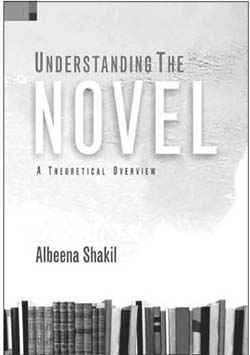One’s first encounter with fiction has been generally through the reading of or listening to fairy tales, mystery tales, superhero stories, popular stories, classic love stories and fantasy novels. And while reading and enjoying them we hardly give a thought to how this enchanting form, both long and short fiction came into existence. Defining the novel is a tricky task since it mediates through various forms of art and adapts itself to the demands of the changing cultural milieus. Yet writers and scholars have understood and elaborated on the defining features and characteristics of the novel in their own ways. According to D.H. Lawrence, ‘The novel is the one bright book of life. Books are not life. They are only tremulations on the ether. But the novel as a tremulation can make the whole man alive tremble.’ It is interesting to see how these words fully capture the essence of this genre and its overwhelming impact on the world of literature.
Albeena Shakil’s Understanding The Novel: A Theoretical Overview is the result of a thoroughly researched doctoral thesis that theorizes the rich array of the novel form by contextualizing its genesis and development in the history of the middle class across European and Indian landscape. Not that other books have not been written on the same subject, the foremost being the massive Oxford History of the Novel in English that runs into several volumes with each volume focusing on the development of the novel in particular historical settings. The book comprises an Introduction followed by five chapters that provide an interesting overview of debates surrounding the emergence of the novel and its survival through varied divergent sub-genres. As one reads the book one finds that the episodic structure of the chapters with sub-headings points towards the multidimensional fictive experience that this literary form provides. The author broadly outlines the approaches to the novel in the Introduction itself and distinctly categorizes the theoretical writings in subsequent chapters.
The novel denotes the power of the written word that surpasses the realm of myth and oral storytelling. It is the product of the technological progress in printing and in circulations of books. The rise of the novel is most notably associated with the fact that the early novel attracted new readers from a range of social classes that were coming into being around Europe in the 18th century. This new readership did not entirely belong to the merchant class (the new bourgeois class) but also included, as J. Paul Hunter says: ‘domestic servants … and people who— with so much reading material available— had learned to read for pleasure’ (The Cambridge Companion to the Eighteenth-Century Novel). In this context Albeena Shakil’s historical approach to the topic is a delight to read as she skillfully investigates the socioeconomic developments in the 18th century pertaining to the development of the novel form. She perceptively links the emergence of the novel in her chapter ‘Rise of the Novel’, to ‘individualism, democratization, anti-traditionalism and subjectivity’ (p. 66). All of these are crucial constituents of the changing historical consciousness of the time. Shakil is particularly keen to formulate the connection between the rise of the middle class and the emergence of the novel. Though the crucial link between the two emerging phenomena cannot be ignored, it becomes an equally exciting exercise to take into account the ‘readership spectrum’ across social classes in the period as compared to focusing on just one particular group. The 18th century was a period of significant transitions in Europe where social categories were, as Michael McKeon says, ‘unstable and most resistant to being strictly identified either as what they are going to be, or as what they once were’.

